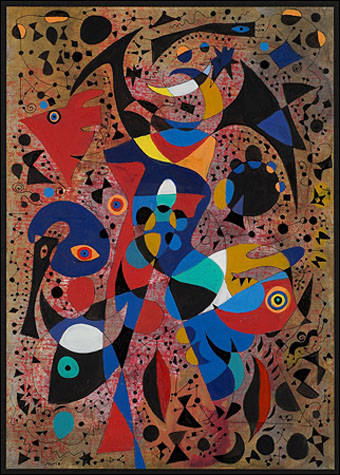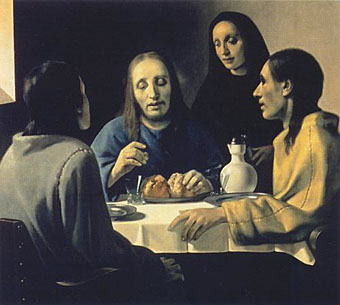
Harlequin Disturbs Sleeping Fish by John Myatt
in the style of Joan Miró (no date).
Fakes and Forgeries: The Art of Deception is an exhibition at the Bruce Museum, Connecticut, running from May 12th–September 9th 2007.
For its major spring/summer exhibition, the Bruce Museum explores a subject that is exceptionally topical in today’s art world. Fakes and Forgeries: The Art of Deception presents 60 examples of Western paintings, works on paper, sculpture and decorative arts that have been recognized as imposters, including examples of the rarest and most famous deceptive works.
Fakes and Forgeries: The Art of Deception reveals the strategies and techniques of the world’s most successful forgers and exposes the extraordinary lengths to which they went to produce authentic-looking artworks. It also addresses techniques used to expose these deceptions, including X-ray fluorescence, pigment analysis, spectrography, dendrochronology, and carbon dating.
The exhibition presents Western painting and sculpture that has been faked from all periods of art, starting with fakes from antiquity and moving chronologically through the Middle Ages, Renaissance and Baroque eras, exposing forgeries ranging from medieval sculpture and quattrocento gold backs to the rare art of Vermeer.

Christ and His Disciples at Emmaus by Han van Meegeren
in the style of Jan Vermeer (1937).
What exactly is a fake or a forgery? Perhaps the biggest problem in this field is the complexity of determining what constitutes an authentic work versus a vast array of faked, forged, copied, attributed, misattributed and replicated work. A fake is a work that replicates an existing work of art; it may be a deliberate deception or simply not the real thing. A forgery is a work that mimics the style of an artist or replicates his signature in a deliberate attempt to deceive.
Paintings in this exhibition that have fake signatures include forgeries of Edouard Manet, Juan Gris, and Giorgio de Chiricio; the etching Le Bain purportedly by Picasso also bears a forged signature. One of the show’s highlights is Han van Meegeren’s legendary forgery, Christ and His Disciples at Emmaus, in the style of Johannes Vermeer, which is arguably the most famous forgery in the world.
Bruce Museum
One Museum Drive
Greenwich
CT 06830
USA

Interesting show. I hope it goes on a tour later on.
Forgers are – by trade – very good and some paintings prove to be even better than original works of a certain painter. I think it was Van Dongen who actually recognised paintings that had been painted by others as his own… No wonder the experts can get it wrong.
Although the term “forgery” – from the legal point of view – imply per se a will to deceive – element which does make it a criminal thing – I think in some case, modern fakes can also be genuine cases of “fan art”; people who are so in love/obsessed with the works of a painter that they will imitate/emulate the style. While most stick to copying of the actual paintings, more gifted painters are able to complement the official collection with their own creations.
I’ve always been fascinated by art forgers, all that dedication to doing something really well but never being able to admit it. I agree it’d be good to see this tour.
British forger Tom Keating who specialised in Constable and Samuel Palmer had a TV series in the 1980s (after he’d been exposed, of course) showing some of his techniques. Fascinating stuff.
In How to Steal a Million (1966)
http://www.audrey1.com/films/million.html
Hugh Griffiths mentions spending months scraping dirt gathered from Van Gogh’s neighbourhood from old 19th century canvases to authenticate his forgeries.
“Van gogh himself wouldn’t have gone to such pains with his work”
“How kind of Van Gogh to use only his first name. I can sign him in half the time”
It’s good to have movies on DVD so you can recheck the dialogue.
Didn’t Dali sign a lot of blank canvases or else add his signature to paintings done by other people in his old age?
PS
Wikipedia has a good article on
http://en.wikipedia.org/wiki/Art_forgery
There’s been rumours about Dali doing that for years although I haven’t read any of the recent biographies so don’t know how accurate the stories are.
PS
for literary hoaxes try Ern Malley
http://en.wikipedia.org/wiki/Ern_Malley
or if you prefer fictional poets how about William Ashbless
http://en.wikipedia.org/wiki/William_Ashbless
Yes, being a fan of The Anubis Gates I’m well-acquainted with William Ashbless.